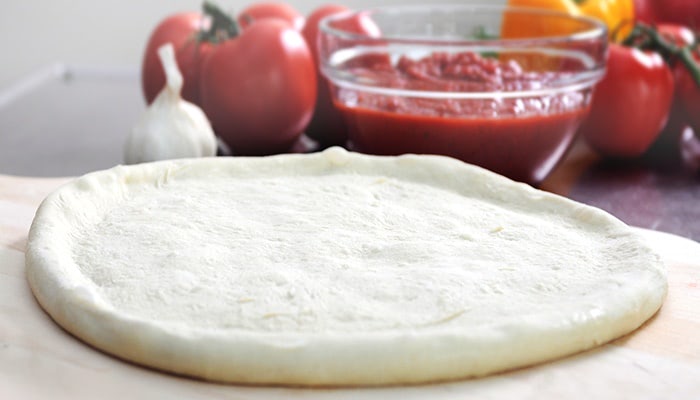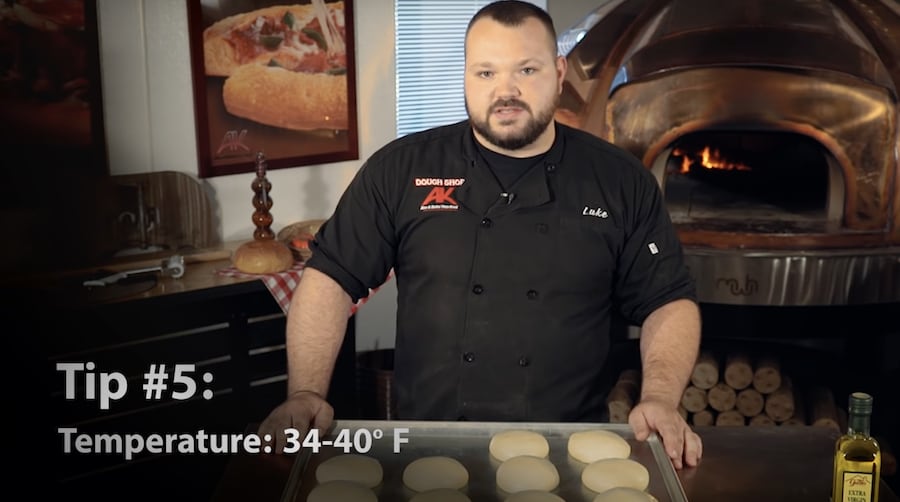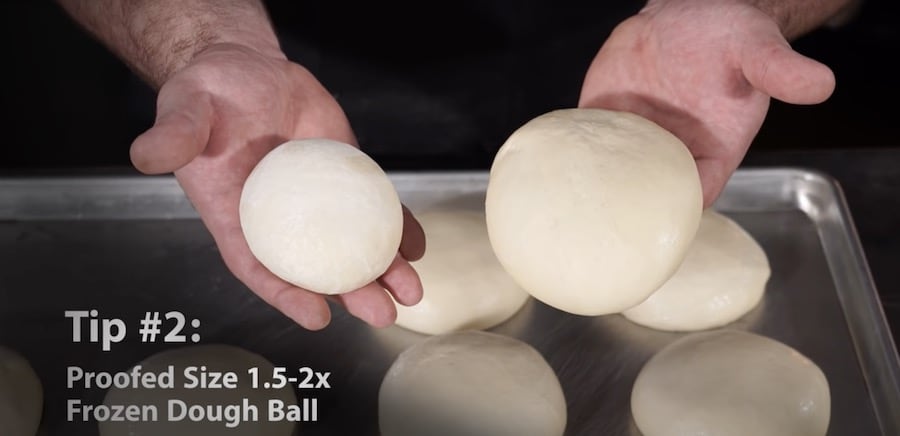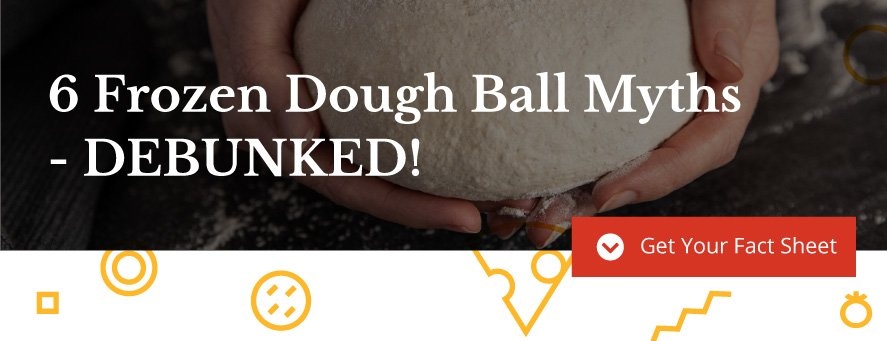
Proofing frozen pizza dough is part science, part art. There's the fine balance of time, temperature, and tools mixed with an experienced knack for judging the proper color and sizing of perfectly proofed dough balls. It all adds up to top-notch pizza and optimal kitchen efficiency.
As the crust and dough experts, the Alive & Kickin’ Pizza Crust team is often consulted about how to proof frozen pizza dough. Check out the Perfectly Proofed Pizza Dough video and answers we compiled to your most frequently asked questions about proofing pizza dough.
Frequently asked questions about proofing pizza dough:
1. Does all pizza dough need to be proofed?
2. How do I go about proofing pizza dough?
3. How long does proofing pizza dough take?
4. How will I know if proofing is successful?
5. How do I know if my pizza dough has achieved proper rise?
6. Can I use under- or over-proofed pizza dough?
7. How do I determine how much frozen pizza dough to proof?
1. Does all pizza dough need to be proofed?
No. Par-baked and live dough crusts require no proofing. Dough balls, on the other hand, require fermentation.
Proofing activates the yeast cells in the dough recipe. The yeast “eats” the sugar in the dough, converting it into alcohol and carbon dioxide — generating the bubbles that make the dough rise and double in size. The proofing process is as important for crust structure and texture as it is for attaining a complex, satisfying flavor that enhances sauce and toppings.
In a restaurant, dough can be proofed in two forms: dough balls and rolled out. Dough for hearth-baked pizzas and most screen pizzas is proofed as dough balls. Pan pizza dough is usually proofed after it’s rolled out and placed in the pan (e.g. a Detroit-style pizza).
2. How to proof pizza dough?
Proofing starts with dough management, which means either cooling or warming dough during proofing so that fermentation — the rate of rise — is either slowed down or sped up.
Fermentation is slowest at 33°F. As the temperature increases, fermentation accelerates until it reaches 100°F, then begins to slow. At 140°F the yeast dies, essentially “killing” the dough.
Pizza dough proofing temperature:

To keep dough from over-rising and failing, minimizing the time it is above 40°F is essential. Use these best practices (and these expert proofing tips) for proper dough management and to avoid over-proofing your pizza dough:
-
Lower the refrigerator temperature. Check your refrigerator’s temperature using a thermometer other than the one installed in the cooler. Is it above 38°F? Consider lowering the temperature to 34°F.
-
Keep the walk-in refrigerator door closed. Even if the refrigerator is set at the recommended 34°F, if the door is routinely opened or propped open for a period of time, temperatures can easily spike to 50°F-plus. It would take at least an hour for the cooler temperature to drop back to the mid-30s.
-
Allow full airflow around dough trays. To ensure a rapid drop in dough temperature, the cold air in the cooler must be able to circulate completely around the trays. Keep the trays off the floor (a pallet or dolly works great) and remember the rule of three: keep a 3" gap between stacks and between the trays and cooler wall. After the dough has reached 40°F, stacks can be moved closer together.
-
Cross-stack dough trays in the cooler. Double-space your trays for about an hour before racking them so dough temperature drops properly. Sheet pans or bakery trays allow for better airflow and more even proofing than fiberglass dough totes (pans with sides). Wrapping dough balls in plastic wrap prevents crusting that can occur when cross-stacking exceeds 90 minutes. If the trays are racked for 60-90 minutes, any crusting will typically disappear within 8 hours as the dough ferments.
3. How long does proofing pizza dough take?
The minimum amount of required proofing time is 24 hours. A 48-hour proof is a better option, and a 72-hour proof is ideal. Since yeast is a living organism, dough balls are good for about five days from the time you pull them out of the freezer until the yeast is spent and compromises dough proofing and rise.
4. How will I know if proofing is successful? How to tell if dough is proofed?
Dough ball coloring is the key indicator. When frozen, dough balls are fairly white with perhaps a little off-white mottling. When properly proofed, dough balls turn yellow. Under-proofed pizza dough is a shade of white that closely resembles the color of a frozen dough ball. Over-proofed pizza dough appears gray.

Size, too, is an important visual cue when you proof pizza dough. Frozen dough balls are fairly small. When proofed correctly, dough balls expand to 1.5 to 2 times their original size.
5. How do I know if my pizza dough has achieved proper rise?
Pay attention to dough performance during proofing and baking.
Proofing indicators
- Properly risen dough nearly doubles in volume compared to when it came out of the freezer, and holds an indentation when gently poked.
- Under-risen dough is tight and springy, and when gently poked, the indentation tends to spring back.
- Over-risen dough is loose, has a rippled surface caused by large air cells, and loses gas and collapses when gently poked.
Baking indicators
- Properly risen dough makes a crust of maximum volume, even grain, white crumb, golden brown surface, and full-bodied yeast bread flavor.
- Under-risen dough makes a crust that’s flat with a tight, dense grain, and bland, biscuit flavor.
- Over-risen dough makes a flat crust with an irregular grain, gummy-grayish crumb, a non-browned and usually blistered surface, bland flavor, and beer-like odor.
6. Can I use under- or over-proofed pizza dough?
No. Under- or over-proofed pizza dough will cook, but it will make for a disastrous customer experience.
Under-proofed dough won't brown properly or crisp up. It will also be extremely bubbly in the oven, to the point where you have to constantly watch for and pop crust bubbles. Over-proofed pizza dough tastes good and will get crispy; however, it will be flat and lifeless because the yeast is spent.
Proofing pizza dough using established best practices is the only reliable way to achieve the flavorful, perfectly risen crust of top-quality pizza. Frozen dough balls make obtaining that consistent quality easier and faster, and could save your operation money in the process.
7. How do I determine how much frozen pizza dough to proof?
In addition to carefully proofing frozen dough and minding dough temperature, two other factors play key roles in dough management:
Production planning
To achieve proper rise, dough-making must align with pizza production.
Before each dough-making session a manager should review pizza sales data to project dough consumption for the desired timeframe.That number, less the amount of dough on hand and the addition of a 10% buffer, equates to how much dough should be taken out of the freezer.
Rotation and First-In-First-Out (FIFO)
Refrigerated dough should be tagged, showing when it was taken out. Then, stock should be rotated in the cooler so the oldest is always used first. Without proper rotation, over- and under-risen dough results.
Frozen pizza dough balls are great for managing proofing practices, time, and prep — but some operators are disillusioned by the rumors of undue prep and expense. Separate fact from fiction by reading 6 Frozen Dough Ball Myths Pizzeria Operators (Probably) Believe. Click the button below to download your copy now.




